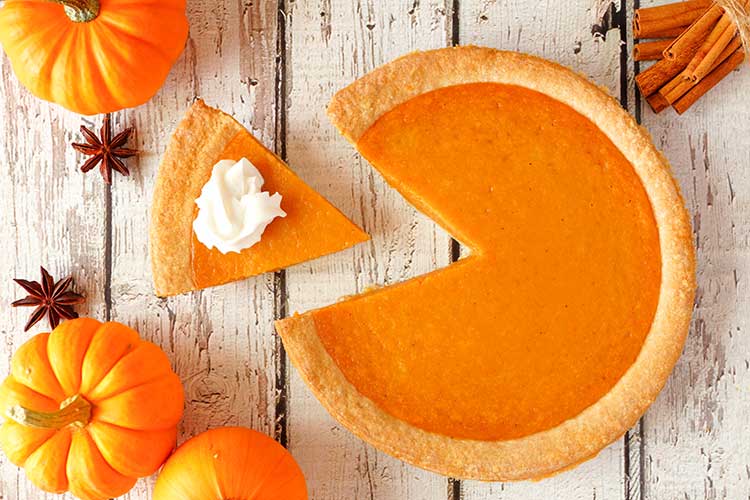Pumpkin spice takes center stage when the Fall season hits. Though used in a variety of foods, the spice blend originated from the pumpkin pie which is a staple during the holiday season in the U.S. However, commercial pumpkin pies fall victim to stability and texture issues due to water migration over time. One option is to use the new Citri-Fi® 600 citrus fiber, a neutral flavored citrus fiber which provides water holding, emulsification and viscosity. As a result, when used at low usage levels (<1%) in pumpkin pie filling, this natural ingredient minimizes cracking, shrinking and weeping.
Tis the season when baristas whip up frothy pumpkin spice lattes and shoppers restock their pantries with pumpkin spice everything. Over the years, pumpkin spice penetrated almost every food group including beer, cookies, candy and even butters. This flavor trend evolved into a tradition which marks the dawn of a new season. Despite pumpkin spice’s trendiness, its popularity originated in the traditional pumpkin pie filling.
Pumpkin Pie Filling Pitfalls
As soon as Fall arrives in the U.S., every baker is pumping out fresh pumpkin pies. And like most shelf-stable foods, pies fall victim of stability issues. Over time, water migration causes water to pool on the surface. As a result, the pie tends to form cracks. And with enough water movement, shrinking causes the edges to pull away and the loose moisture turns the crust soggy. These unalluring visuals could sway any customers to alternatives like apple pie.
Most pumpkin pies rely on egg to bind the water and oil which minimizes the weeping. However, depending on the pie formulation, egg alone cannot prevent water migration. And because of egg availability issues and price fluctuations, some producers try to reduce the egg content as a cost savings strategy. This further reduces the egg functionality causing water binding issues. Some workarounds include applying a gel-based surface coating containing different hydrocolloids to mask the weeping and prevent cracking. However, this technique does not address the soggy crust. Another option is to add water binding ingredients such as modified starches, alginates or food gums to the filling.
Egg Reduction & Clean Label
Another solution is to incorporate citrus fiber. The new Citri-Fi 600 citrus fiber line is recommended for bakery fillings such as pumpkin pie filling. At low usage levels (<1%), this neutral flavored citrus fiber provides high water holding and emulsification properties in addition to high viscosity. Because of this, water is bound to prevent the cracking, shrinking and weeping. Moreover, Citri-Fi can also improve the stability and texture of the pie when eggs are reduced. For instance, bakers can reduce eggs up to at least 50% when using 1% of Citri-Fi 600 citrus fiber.
Citri-Fi is easily incorporated into the pie formulation by mixing it with the dry ingredients such as spices, salt or sugar. This step is key before introducing the liquids such as pumpkin, milk and water. The dry ingredient mix is then added to the wet ingredients to create a uniform mixture.
Using Citri-Fi 600 not only improves the overall quality of the pumpkin pie but it also can help reduce the number of ingredients in the pie formulation. As a result, bakers benefit from cleaner and more natural food labels. Citri-Fi 600’s labeling options include citrus fiber, dried citrus pulp or citrus flour which resonate well in the natural food markets.
Other Bakery Filling Benefits using Citrus Fiber
Besides heat stability, Citri-Fi 600 is also freeze/thaw and low pH stable. It is non-GMO Project certified, allergen-free and gluten-free. Citri-Fi 600 also has no e-number which is key for certain regions like Europe. An USDA certified organic version, Citri-Fi 700, will be launching soon.
For more information about Citri-Fi 600 citrus fiber in pumpkin pie filling or other bakery fillings, please contact us.


